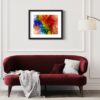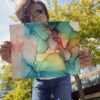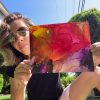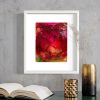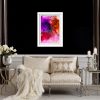 Ah, alcohol ink—my liquid muse, the technicolor potion that brings my artistic visions to life.
Ah, alcohol ink—my liquid muse, the technicolor potion that brings my artistic visions to life.
If you’re reading this, you’re either a fellow artist, an intrigued dabbler, or perhaps someone who just loves to watch vibrant colors do a magical dance on non-porous surfaces. Whatever brought you here, you’re in for a treat. Today, we’re going to unravel the mysteries of alcohol ink color properties. Spoiler alert: it’s going to be fun.
The Chemistry of Wow: What Makes Alcohol Ink Pop
Let’s start with the basics. Alcohol ink is like the rockstar of the art world—bold, unpredictable, and absolutely captivating. The secret to its brilliance lies in its makeup. Unlike water-based inks, alcohol inks are alcohol-based (surprise!), which means they evaporate quickly, leaving behind only the most concentrated, dazzling colors you can imagine. It’s like painting with liquid fireworks.
Now, here’s where things get interesting. The colors in alcohol inks are super pigmented, which is a fancy way of saying they’re ridiculously intense. This is great news for anyone who likes their art to scream, “Look at me!” But there’s more to these inks than just their in-your-face hues. Each color has its own personality, and getting to know them is like making a new friend (or frenemy, depending on how they behave).
Transparency vs. Opaqueness: The Yin and Yang of Ink
Not all alcohol inks are created equal. Some are as transparent as a politician’s promise, while others are opaque enough to cover up your last artistic oops. Understanding this difference is key to mastering your medium.
Transparent colors are like those friends who tell you what you need to hear, even if it’s not what you want to hear. They’re honest, allowing the underlying layers to show through, creating depth and complexity in your work. Want to create a dreamy watercolor effect? Transparent inks are your go-to.
Opaque colors, on the other hand, are the life of the party—they cover everything in their path, making a bold statement. These are perfect when you want to add solid blocks of color or need to correct something that didn’t quite go as planned (we’ve all been there).
The trick to working with these inks is knowing when to let the transparency shine and when to embrace the opacity. It’s a delicate balance, but one that can lead to some truly stunning results.
 The Color Wheel: Your New Best Friend
The Color Wheel: Your New Best Friend
Remember the color wheel from art class? The one that helped you figure out why your red and green painting looked like mud? Well, it’s time to revisit that old friend because it’s just as important with alcohol inks.
When you’re mixing alcohol inks, the color wheel will save you from some truly tragic combinations. Complementary colors (those opposite each other on the wheel) will create contrast and drama, while analogous colors (those next to each other) will blend harmoniously. Of course, rules are meant to be broken, but it’s always good to know them first.
Here’s a pro tip: Keep a scrap piece of Yupo paper handy to test out your color mixes before committing them to your masterpiece. This little practice can save you from a lot of frustration—and wasted ink.
Layering and Blending: The Art of Controlled Chaos
Now, let’s talk about layering and blending—two techniques that can either make you feel like an artistic genius or send you into a colorful spiral of despair. But fear not, because once you understand how alcohol inks interact with each other, you’ll be layering and blending like a pro.
Layering is all about patience. Each layer of alcohol ink dries quickly, but if you’re too hasty, the next layer can re-wet the first and create a muddy mess. Take your time, build your colors gradually, and watch as your piece transforms into a multi-dimensional marvel.
Blending, on the other hand, is where the magic happens. Alcohol inks love to blend, and with a little help from some isopropyl alcohol or a blending solution, you can create smooth transitions, dreamy gradients, or even a swirling vortex of color. The key is control—too much blending, and your colors will all mix together; too little, and they’ll sit awkwardly on top of each other like a bad first date.
Your Ink, Your Rules
At the end of the day, working with alcohol inks is about embracing the unpredictability of it all. Yes, understanding color properties will give you a solid foundation, but the real joy comes from letting go and seeing where the inks take you. So, grab your favorite colors, channel your inner child, and start experimenting. Who knows, your next masterpiece might just be a happy accident away.
If you’re passionate about taking your alcohol ink artistry to the next level, consider booking an artist coaching session with me. I’ll guide you through the techniques and creative processes that can help you become the latest and greatest alcohol ink artist, unlocking your full artistic potential.
Let’s turn your passion into extraordinary art!




 The Color Wheel: Your New Best Friend
The Color Wheel: Your New Best Friend